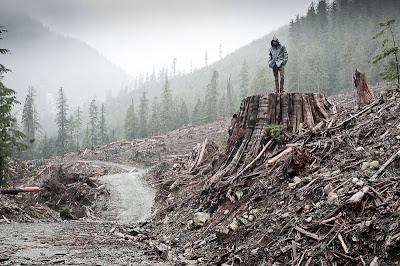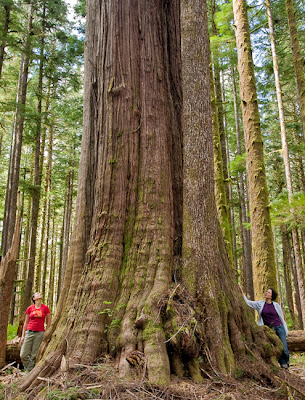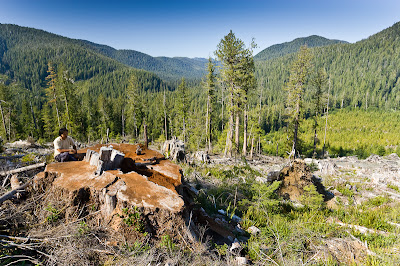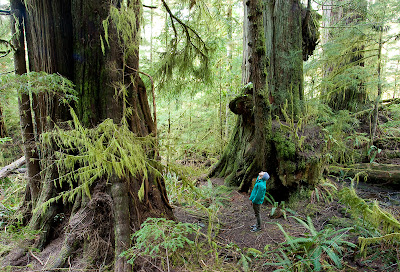On March 29th 1778 when Captain Cook and the first Europeans sailed down the the Nootka Sound on the northwest coast of Vancouver Island they discovered an amazing, seemingly endless forest of huge trees that flourished from the seashore to the mountain tops and stretched in a belt up to several hundred miles wide down the Pacific coast of North America, from British Columbia in the north down through Washington and Oregon and right down into northern California.
 |
| The Cheewhat Cedar is Canada's largest tree, located in the Pacific Rim National Park on the southwest coast of Vancouver Island it stands 55.5m (182ft) tall and has a circumference of 18.3m (60ft) Photo by TJ Watt of the Ancient Forest Alliance |
It wasn't until 1848 that the first sawmill was opened near Victoria on the southern tip of Vancouver Island with others soon following. The early logging techniques were hard and labourious with the huge logs being hauled out by teams of oxen which were later mostly replaced by horses which were thought to be smarter and stronger.
Successive technological advances in haulage and sawmilling together with the arrival of the portable chainsaw in British Columbia during the early 1930's resulted in an astonishing rate of forest destruction with little or no regard to the magnificence of these temperate rainforests, the gigantic trees that exist within them and the fragile ecosystems that they support.
150 years of logging in British Columbia has converted a large portion of its once magnificent primeval forests into second growth tree plantations. Although the trees grow back, the 50-60 year cut rotation does not allow enough time for the forest to regain its prior old growth characteristics. The second growth forests typically lack the multi-layered canopy, rich understory and rotting wood debris that makes old growth such a valuable habitat for so many plant and animal species.
The Government of British Columbia contests that old growth forests are not endangered and is doing little to protect what remains. Environmental organizations and the people of BC are however putting intense pressure on the government to recognize the significant importance of these world class forests.
 |
| This stunning photo by TJ Watt of the Ancient Forest Alliance perfectly captures the horrific reality of clearcutting. To appreciate its full impact please view this photo in full size and resolution on Utopia Photo Blog The photo was taken at Bugaboo Creek in the Gordon River Valley near Port Renfrew on Vancouver Island in March 2010, 3 years after felling "Of the tens of thousands of images I've shot over the years trying to capture the devastation happening to BC's temperate rainforests, I feel that this one sums it up best. Without experiencing these clearcuts in person it's nearly impossible to convey the scale, contrast, and emotional impact involved with the loss of such amazing endangered ancient forest. It's the golden goal to find the photo that will be efficient and summarize the story for you in a single shot."-TJ Watt |
The structure of land ownership is very different to what we in Europe are familiar with. In Canada the vast majority of land is held by the government on behalf of the monarchy and refered to as Crown Lands. In British Columbia an astonishing 94% of the land area is Provincial Crown lands with just 5% being privately owned. The remaining 1% are Federal Crown Lands that include Indian reserves, Defence Lands and Federal Harbours.
The sale of Crown Lands and the licences to exploit the mineral resources that exist underneath it, as well as the vast forests that cover it's surface all provide an important revenue to the government. It is the government that issues the licences over specific areas known as cut blocks that allow private companies to exploit the forest resource and so logically it follows that it is the provincial government that can legislate to provide permanent protection to the remaining areas of ancient forest so that they can be experienced and cherished by future generations.
The sale of Crown Lands and the licences to exploit the mineral resources that exist underneath it, as well as the vast forests that cover it's surface all provide an important revenue to the government. It is the government that issues the licences over specific areas known as cut blocks that allow private companies to exploit the forest resource and so logically it follows that it is the provincial government that can legislate to provide permanent protection to the remaining areas of ancient forest so that they can be experienced and cherished by future generations.
 |
| This huge cedar known as the Elephant Foot Tree stands as a lone giant in the forest. It stands along the Gordon River near Port Renfrew on Vancouver Island. This tree lacks any legal protection in an area that is open to logging. Photo by TJ Watt of the Ancient Forest Alliance and taken from their Biggest Trees Gallery |
Motivated by the lack of governmental action on environmental protection the Western Canada Wilderness Committee was formed during the early 1980's. Its campaigns have played a significant roll in the formation of many Provincial Parks, National Park Reserves and Conservation Areas.
With a membership of over 30,000 spirited supporters they work to protect all Canadian wildland areas from destruction and defends the right of public access to them. Without their campaigns to raise public awareness to the catastrophic forestry policy that has been followed by successive provincial governments in British Columbia many of the last remnents of old growth forest would have been destroyed.
The Formation of the Ancient Forest Alliance
In January 2010 Ken Wu, the former Campaign Director for the Western Canada Wilderness Committee along with TJ Watt and a few other activists decided to launch a new ENGO (Environmental Non-governmental organization) called the Ancient Forest Alliance. They felt a specific need to focus attention against the continued Old Growth logging that still continues to be licensed and supported by the provincial government in British Columbia.
 |
| Recently clearcut ancient forest in the Upper Walbran valley on Vancouver Island, Ken Wu, campaign co-ordinator for the Ancient Forest Alliance sits on a 14ft diameter Red Cedar stump surrounded by "tree waste" and other huge stumps. Photo by TJ Watt of the Ancient Forest Alliance |
- To undertake a Provincial Old-Growth Strategy that will create an inventory of the old-growth forests in BC and protect them where they are scarce (ie. Vancouver Island, southern Mainland coast, southern Interior, etc.)
- Ensure the sustainable logging of second-growth forests, which now constitutes the majority of forest lands in southern BC.
- End the export of BC raw logs to foreign mills in order to ensure a guaranteed log supply for BC mills and value-added processing facilities.
- Assist in the retooling and development of BC coastal sawmills and value-added facilities to handle second-growth logs.
- Undertake new, democratic land-use planning processes to protect endangered forests based on new First Nations land-use plans, ecosystem-based scientific assessments, and climate mitigation strategies through forest protection.
 |
| I cannot imagine being privalaged enough to own a mighty Douglas Fir of these dimensions, so to see such a beautiful log left as wood waste is beyond my comprehension. Photo by TJ Watt, Ancient Forest Alliance |
The organisation has also chosen not to have charitable status which makes it harder for them to get donations. Charities in Canada are not permitted to be critical of government policies, obviously to be non political would put the AFA in an almost impossible position as their main driving force is to stop the destruction of the last remaining old growth forests which is being caused directly by the forestry policy of the provincial government. They can now directly criticize or congratulate individual politicians or parties on their stance on old-growth forests - something you MUST be able to do in order to win such a big battle. They are also helping train and empower activists in Ancient Forest Committees that will work in key provincial swing ridings to directly put pressure on politicians and their forest policies. This has resulted in a no frills, highly active, grassroots organization that's becoming the driving force in the fight to protect BC’s endangered ancient forests and forestry jobs.
Old-growth forests are important because they are home to a large array of biodiversity, including many species at risk that need old-growth forests and that can't flourish in younger forests.
It provides clean water for people, spawning salmon, and wildlife by preventing the soil erosion that occurs in these mountainous, high rainfall areas when the trees are lost and new roads and logging tracks established.
An increasing global awareness of the environmental importance of these unique temperate rainforests and the sheer immensity of the giant trees that can only grow within them have become fundamental pillars of BC's multi-billion dollar tourism industry.
 |
| An amazing group of ancient redcedars.The surrouding areas were all logged within the past 100 years but for some reason these magnificent trees were spared. These trees are along the trail to the Red Creek Fir - the worlds tallest Douglas Fir Tree near Port Renfrew on Vancouver Island. Photo by TJ Watt of the Ancient Forest Alliance |
It is now clear that in hard financial terms these trees are worth much more to British Columbia in hard dollars still standing than they are as a timber commodity. If these last remaining forest fragments are lost it will take a second growth forest at least 250 years to start to regain the charcteristics of old growth forests.
Unfortunately, the British Columbian provincial government and much of the forest industry maintains that “old-growth forests are not endangered” on Vancouver Island. They continue to make these false statements despite all the evidence from satellite pictures. They continue to promote misleading statistics to justify their continued destruction of the Old Growth Forests. In an attempt to pacify the public they’ve been greatly inflating the statistics of the remaining old-growth forests and protected areas by including vast tracts of stunted forests that grow in bogs and sub-alpine snow forests. Most of these forest cannot profitably be logged but are included in the statistics to make the figures look good. The fact is that over 90% of the original old growth forest in the valley bottoms have already been logged. This is home to the biologically richest areas of forest and are where the biggest trees grow.
The Export of raw logs from British Columbia to China and the USA.
During the past decade, timber companies such as TimberWest have closed sawmills and secondary wood processing facilities in British Columbia and have for economic reasons decided to export the raw logs to other processing facilities mainly in China and the USA. This has led to a loss of over twenty thousand skilled jobs in the timber processing industry in British Columbia and the closure of over 70 sawmills and wood processing facilities. During the last 8 years over 30 million cubic meters of raw logs have been exported for secondary processing in foreign sawmills mostly located in China and the USA.
The Ancient Forest Alliance recognises the need for a healthy forest industry and they are calling on the provincial goverment of BC to undertake the following actions
- End the export of raw logs from British Columbia to foreign mills in order to ensure a guaranteed log supply for BC wood processing facilities.
- Assist in the retooling of coastal BC sawmills and the development of value-added facilities to handle second-growth logs.
- Ensure the sustainable logging of second-growth forests, which now constitutes the majority of forest lands in southern BC and to end the practice of “high-grade” over-cutting of the biggest, best old-growth trees in the valley bottoms and lower elevations.
- Undertake a Provincial Old-Growth Strategy that will create an inventory of remaining old growth forest and protect what remains in regions where they are scarce (eg’s. Vancouver Island, Southern Mainland Coast, Southern Interior, etc.)
 |
| A map of Vancouver Island from 1860 showing the extensive old growth forest that once blanketed the island |
 |
| The same map but from 2004 showing the almost complete logging that has occured on Vancouver Island in just a little over 140 years. Data courtessy of the Sierra Club and can be seen as larger versions on the website of the Ancient Forest Alliance |
Sitting just off the west coast of Vancouver Island lies Flores Island. It's 7113 hectares are covered with amazing coastal rainforest that remain virtually untouched by logging companies. This unique complete ecosystem remains 96% intact. The provincial government of British Columbia has however issued licences for areas to be clearfelled.
 |
| The latest campaign by the Ancient Forest Alliance is to try to stop planned clearcutting from taking place on Flores Island which lies just off the west coast of Vancouver Island. The islands 7113 hectares of ancient forest are 96% intact Photo by TJ Watt of the Ancient Forest Alliance |
This is a description of Flores Island made by the AFA. "Flores Island is one of the largest contiguous tracts of old-growth rainforest left on BC’s southern coast and is certainly among Earth’s most stunningly scenic places. The largely unlogged island is home to large populations of cougars, wolves, bears, and deer in its ancient forests and gray whales, humpback whales, porpoises, orcas, sea otters, and sea lions in its marine waters.
Spectacular old-growth redcedar and Sitka spruce stands have been recently surveyed and flagged for logging on eastern Flores Island, which has some of the densest stands of giant trees in the world, and
landing pads for heli-logging have been carved into the forest. Logging could begin as soon as early 2011".
What can you do to help?
- Please sign the Ancient Forest Petition by adding your name and show the BC Government that people from all over the world care about what happens to these remarkable trees and forests.
- Join the Ancient Forest Alliance (2nd group) on Facebook and keep up to date with new photos and campaign information.
- Write a letter to show your concern. Every letter represents hundreds more people who feel the same way. Your message will be automatically addressed to BC's Premier Gordon Campbell as well as BC's Minister of Forests and Range Pat Bell.
- Donate if you are able. Although the AFA is a non-profit organisation the success of the campaigning to raise public awareness inevitably leads to expenses on essential items such as minimal core staff requirements, travel costs, phone bills, web work, room bookings, printing costs, and more.
- Subscribe to the AFA's video channel on YouTube
 |
| Sitka Spruce at it's pinnacle of development in the Temperate Rainforest of Canada's Pacific coast, covered in epiphytes in its natural environment. To anyone from the UK this is the environmentalists most hated tree, planted in its hundreds of millions in the northwestern parts of Britain, especially Scotland in dark, sterile monocultures. But to see Sitka Spruce growing like this, in it's natural habitat has really changed my perspective on this giant of the Pacific forests. Photo by TJ Watt of the Ancient Forest Alliance |
I would like to thank TJ Watt for giving me permission to use his remarkable photos and also to all the members of the Ancient Forest Alliance for their tireless efforts in trying to save these remarkable giant trees and the unique forests that they are a part of.


"Why do we need to protect old growth forest?" Because before they belong to us, they belong to themselves. Thank you for a stunning article and photographs that make me weep. I support your work in every way.
ReplyDeleteThank you for helping raise the awareness of this important issue. I've been following the Ancient Forest Alliance as well as the Vancouver island big trees http://vancouverislandbigtrees.blogspot.com
ReplyDeleteKeep up the great writing! We need to educate people on the necessity of these old growth forests. I live in the North East in the US, where there is little to no old growth forest. All of it is second growth after generations of extensive logging.
Very comprehensive post - thank you. Our work here is ongoing as old growth continues to be liquidated. AFA is doing good work to help protect what is left. This is a global treasure of major significance, and they are destroying it to make decks and siding. NO MORE OLD GROWTH LOGGING!
ReplyDeleteClearing old growth forests is unnecessary, short-sighted and ignorant, especially for the stupidity of generating temporary operating revenue and profits. Once the old trees are gone and the area is cleared, the unique soil properties, particularly the stellar fungi to bacteria ratio that took thousands of years to create, is changed and probably lost forever. Nothing "renewable" about that.
ReplyDeleteThere’s another one on the other side of the room. McAlpine loves screens and uses them to divide rooms and also to create vignettes. Smarter Flooring
ReplyDelete